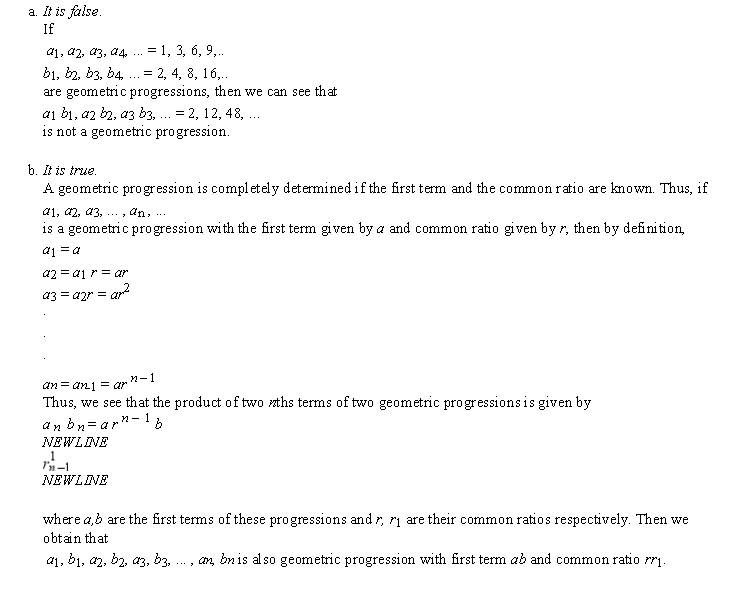Determine whether the statement is true or false. If it is true, explain why it is true. If it is false, give an example to show why it is false.
If a1, a2, a3, ... , an and b1, b2, b3, ... , bn are geometric progressions, then a1 b1, a2 b2, a3 b3, ... , an bn is also a geometric progression.
A) It is false.
If
A1, a2, a3, a4, ... = 1, 3, 6, 9,..
B1, b2, b3, b4, ... = 2, 4, 8, 16,..
Are geometric progressions, then we can see that
A1 b1, a2 b2, a3 b3, ... = 2, 12, 48, ...
Is not a geometric progression. 
B) It is true.
A geometric progression is completely determined if the first term and the common ratio are known. Thus, if
A1, a2, a3, ... , an , ...
Is a geometric progression with the first term given by a and common ratio given by r, then by definition,
A1 = a
A2 = a1 r = ar
A3 = a2r = ar2
.
.
.
An = an-1 = ar n - 1
Thus, we see that the product of two nths terms of two geometric progressions is given by
A n b n = a r n - 1 b  where a,b are the first terms of these progressions and r, r1 are their common ratios respectively. Then we obtain that
where a,b are the first terms of these progressions and r, r1 are their common ratios respectively. Then we obtain that
A1, b1, a2, b2, a3, b3, ... , an, bn is also geometric progression with first term ab and common ratio rr1.
Correct Answer:
Verified
Q174: A printing machine that has an estimated
Q175: For the geometric progression, find the sixth
Q176: As part of her fitness program, Karen
Q177: Suppose the cost-of-living index had increased by
Q178: Determine whether the sequence is geometric progression
Q180: For the geometric progression, find the sixth
Q181: Find the nth term of the arithmetic
Q182: Find the sum of the first 16
Q183: As part of her fitness program, Karen
Q184: An employee of Stenton Printing whose current
Unlock this Answer For Free Now!
View this answer and more for free by performing one of the following actions

Scan the QR code to install the App and get 2 free unlocks

Unlock quizzes for free by uploading documents